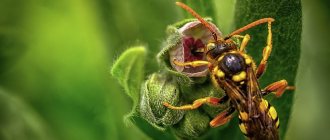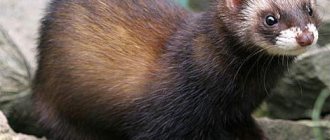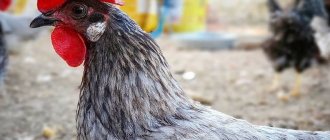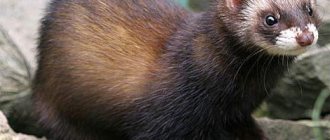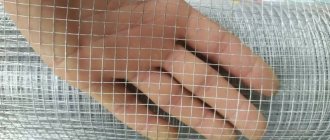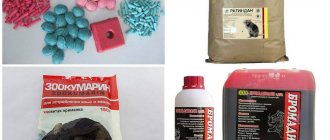There is a whole family of small rodents commonly kept as pets. Some of them are quite easy to tame and enjoy interacting with, while others are more timid.
Some are more active at night, which may not suit some people's lifestyles. However, they are fairly easy animals if you provide them with adequate housing, exercise and food.
If you're looking for a small, furry companion, here are the 10 best small rodents to choose from.
Tip: Many pet rodents are quite fragile animals. Teach anyone who will interact with your pet, especially young children, to be especially gentle and careful.
Angora rabbit
Angora rabbit
These rabbits were imported from Poland. Their colors vary. What’s interesting about rabbits is their “clothing”: up to 30 days, rabbits look like “ugly ducklings”, and by the 50th day they become “beautiful swans”. You should not breed those rabbits that have poor head pubescence. The rabbit must be constantly combed with a brush and cut out the rolled fur.
Interesting: The largest fish in the world - list, sizes, names, where they are found, photos and videos
Characteristics and features
Rodents appeared on the planet more than 60 million years ago and have evolved greatly since then. Some species developed and changed, others completely disappeared.
Representatives of the rodent order inhabit a wide variety of climatic zones, living in warm and cold, wet and dry places, near water bodies and deep in forests, on plains and in mountainous areas. They live on the ground, underground, in trees, in swamps. And some species have even mastered the airspace, for example, the flying squirrel.
Various rodents exhibit vital activity either at night and twilight, or during the daytime.
These mammals can exist in groups with different numbers of individuals or be solitary. Their brain is quite large in size and does not have convolutions on its surface. Rodents are quite smart animals, they can perform the simplest actions, they have their own language for communication.
Well-developed sensory organs responsible for tactile sensations, hearing and smell enable rodents to recognize danger in time and avoid it, communicate with their own kind, find food and everything necessary for existence.
Rodents have elongated intestines. This is due to the consumption of food mainly of plant origin.
Family Gilts
Gilts live exclusively in South America in its most diverse climatic zones.
Representatives of this family have an elongated body, four-toed forelimbs and three-toed hind limbs, a short tail and neck, and a large head. Ears may be short, long, or absent altogether. The hairline is usually rough. The fur on the back is brown, gray, black or olive. The belly is light: color from white to dark yellow. Some species are nocturnal, others diurnal. However, none of them hibernate.
The family consists of 5 genera, which are represented by 15 species.
Abyssinian guinea pig
Peruvian guinea pig
Brazilian pig
Guinea pig
Decorative mouse
Decorative mice are, in essence, distant relatives of the well-known house mice (yes, the same ones that have the habit of settling not far from human homes and often “peeping into the light” of country houses in the autumn-winter period).
The only difference between such mice and their wild relatives is their colors - they are not found in nature.
Mice are social animals, so it is best to keep them in pairs or groups consisting of only females. Males will almost certainly not be able to live with each other.
Domesticated rat
Unlike their wild ancestors, modern domesticated rats are practically not afraid of people and willingly make contact. These are smart animals with a calm and “non-conflict” character.
Like any social creatures, they require constant communication, so in the absence of a “companion” they may begin to experience psychological stress. However, as practice shows, rats very quickly find a common language with humans and, if the latter pays enough attention to the animal, it becomes a faithful and devoted pet.
Squirrel family
The family is divided into 5 subfamilies containing approximately 230 species. The most famous are the squirrel and the gopher.
Rodents of this family are widespread on all continents with the exception of Australia and Antarctica. A number of Arctic and tropical islands are also not inhabited by Squirrels.
These rodents can be small or large. Body length varies between 6-70 cm. Weight ranges from a few grams to 9 kg. All have a long tail covered with fur. Squirrels have strong, developed limbs and large eyes. The hair color can have stripes, spots or be one color: red, black, white, etc.
Chipmunk squirrel
prairie dog
Magellan tuco-tuco
Little chipmunk
Little gopher
Palm squirrel
Chinchilla
Chinchilla
These furry creatures were brought from South America. They reach small sizes and look like rabbits and squirrels at the same time. The animal has a large head, large and expressive eyes, a short neck, small legs, and a long tail. Rodents live up to 20 years. Their fur is very durable and thick.
Interesting: The largest lakes in Russia - list, names, area, depth, photos and videos
The room for keeping a chinchilla at home should be bright, well ventilated, dry and warm. This can be either an aviary or a cage. The chinchilla eats almost everything, but do not forget that it must always have hay.
Family Mole rats
Mole rats are burrowing animals that are adapted to life underground. The family is divided into three subfamilies, which include more than 30 species of rodents.
Characteristic features of animals of this family are half-blind eyes, underdeveloped ears, short thick fur, and short limbs. The length of the body of various species can be from 0.13 to 0.48 m, and weigh from 100 g to 4 kg. Some species have powerful incisors with which they dig the ground. Other rodents use their front paws for this.
Mole rats live in Europe, Asia, and northeast Africa. They are also found on Russian territory.
Small bamboo rat
Lesser mole rat
Large rodents
Hedgehog
Features of caring for a hedgehog directly depend on its breed. These pets are not picky about home conditions - a large cage and a house with a feeder will be enough. Filler, for example, cat litter, is poured onto the bottom. There is no need to clean it more than 1-2 times a week so as not to frighten the animal. The hedgehog is active at night, but this can be corrected - it is enough to feed him during the day so that he gets used to this routine. A hedgehog's normal diet consists of worms, insects and light meat, as well as dairy products. They live for about 10 years.
Chinchilla
These are affectionate animals with good intelligence. The main advantage is that chinchillas do not have an unpleasant odor or skin diseases. They are herbivores, so they should be fed with special food, herbs, dried fruits and berries. A large cage with a designated area for a nest is suitable as a house. It is necessary to maintain the temperature around 18-20 C; an increase can be dangerous. You cannot wash your chinchilla, otherwise the fur will mat. They live up to 14 years with proper care.
Hare
A hare should not be picked up from the forest unless it is certain that it will remain for a long time. It is not recommended to keep it at home as it is a wild animal. However, if a bunny comes into the house, it should be fed with dog or cat milk substitutes. From a certain age, include greens, fruits, and vegetables in your diet. You need to keep it in an enclosure, periodically letting it out for a walk under supervision. In captivity they live up to 12 years.
Rabbit
It is better to have a short-haired rabbit. They are quiet animals that do not need to be walked regularly. At home, the rabbit is kept in a medium-sized terrarium or cage with hay or sawdust. It is necessary to monitor a comfortable temperature, since they do not tolerate heat and hypothermia well. Acceptable - 18-20 C. To prevent an unpleasant odor in the cage, you need to clean it regularly using disinfectants. The main diet is mixed feed, hay and clean water. Life expectancy is up to 12 years.
Gopher
It is not recommended to keep a gopher in an apartment due to the very strong smell; a spacious enclosure on the territory of a private house is better. Special products are needed to clean it. These are herd animals, so they will not live long alone. Food for gophers is available at the pet store, and you can also give them greens, fruits, and some flowers. The lifespan of the animal is 3-4 years.
Marmot
It has several names - boibak or steppe marmot. A wide cage with strong bars and bars is suitable as a house for an animal. It should not be placed in a cramped room with electrical appliances. These are restless and active rodents, so it is better not to leave them unattended to avoid chaos in the house. They eat mostly ordinary fruits and vegetables; exotic ones should not be given. The bowl should be removed immediately after eating so that the groundhog does not drop it. These animals live up to 15-18 years.
Ferret
The ferret, a type of forest ferret, is suitable for home keeping. These rodents quickly adapt to their surroundings. Caring for them is not very difficult, but it will require a lot of money. It is recommended to seal all cracks in the apartment to prevent the ferret from chewing through anything. It is better for him to live in a spacious enclosure, a separate room or on a loggia with insulation. Feed with special food, vitamins, and sometimes mouse carcasses. A big plus is that ferrets can be owned by people with allergies, since their fur does not cause reactions. The main disadvantage is the unpleasant odor from the fur. They live up to 7-9 years.
Nutria
The animal loves warmth, so during the cold season you cannot keep it in an open cage - this is dangerous. The temperature should not be lower than -15 C. It would be correct to organize a pond in the yard for nutria, where the pet will sunbathe. Favorite delicacies are branches, plants, various shellfish. Compound feed can only be fed in a soaked form. The cage should be cleaned regularly to avoid a strong smell. Nutria live up to 6-7 years.
prairie dog
Prairie dogs belong to the squirrel family. Keeping them at home is not easy, because they are not a hamster or a rat, but a wild animal. An aquarium or a large cage where the rodent can dig its holes is suitable as a house. These are heat-loving creatures, for which a comfortable temperature should be above 17 C. The main diet is hay of various types. Taming a prairie dog will be difficult and requires patience. Respiratory tract diseases to which there is a predisposition should not be allowed. With good care they live up to 7-8 years.
Hamsters
They are funny, but can show character - behave aggressively, even claw at the feeding hand. A bad mood is guaranteed when they are asleep if they are forcibly awakened. There are rodents with a pleasant character. Golden or Syrian hamsters are considered loners. If you add another to one animal, they can fight for several days. It is better to keep each one in a separate cage. Maintenance is easy, but the litter needs to be changed more often. Veterinarians recommend corn filler: it doesn’t create as much dust and doesn’t get into the eyes as small sawdust. Hamsters have a life cycle of about three years.
Family Hedgehogs
The species composition of this family is not the largest. However, 24 different species are known.
All Ezhovs have a number of characteristics that unite them into one family. These include a pointed, elongated muzzle, well-developed eyes and ears, and limbs with five fingers. A distinctive feature of the family is the skin with many needles interspersed with hairs of wool. These rodents also have a special muscle that runs through their entire body. She helps the animal curl up into a ball, escaping from predators.
The habitat of hedgehogs is Central and South Asia, Europe. They were once introduced to islands near Africa, where they spread safely.
Hedgehog
Family Jerboa
These rodents live in desert, semi-desert, steppe, and low mountain areas. They inhabited northern Africa, some parts of Europe, Asia, Kazakhstan, southern Siberia, etc.
These mammals have a short body, elongated hind legs, and short forelimbs, with which they remove the earth dug out with their incisors. The size of these rodents is 4-25 cm, weight no more than 300 g. All species have a very long tail, which serves as a rudder and balancer when running. These animals have a short neck, a large head, long rounded ears and a uniform skin of beige-brown shades.
Jerboas, with rare exceptions, are nocturnal. They dig burrows, feed on plants and insects, and bear offspring one to three times a year.
Small jerboa
Desert jerboa
Guinea pig
This small animal can have long colored fur, which makes it even more attractive. The guinea pig has an affectionate, sociable and good-natured disposition. The vulnerable and timid little animal eats hay and vegetables.
He rarely bites and needs a calm environment. Therefore, it is advisable to protect him from stress. This small rodent is not able to live alone and feels comfortable in the company of its relatives.
Small rodent - guinea pig
